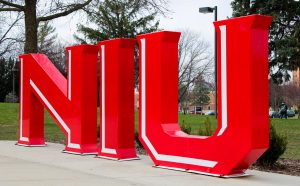Northern Star Playlist: Bruce Springsteen
August 28, 2019
“Blinded by the Light” was released Aug. 16, and now dads across the nation are reminiscing about the Bruce Springsteen tunes that provided the soundtrack to their coming of age. While Springsteen’s sound varies greatly from record to record, his albums are united in their political undertones and distinct, working class American identity. If you want to get into Bruce Springsteen, or if you’re are under the misapprehension that “Born in the USA” is a fist-pumping patriotic anthem, this playlist is a good place to start learning about what The Boss is all about.
Tenth Avenue Freeze Out — Born to Run
“Freeze Out” is a punchy, upbeat tune that does well to demonstrate the mastery of the E Street Band’s “wall of sound” construction. Jaunty horns and a warm staccato piano riff open the song, which tells the story of the formation of the E Street Band, making it a good introduction to Bruce Springsteen’s discography. While the studio version clocks in at just over three minutes — short, by Springsteen’s standards — the live version can last up to a whopping 16 minutes, as found on the “Live in New York City” album. Not only is this a fun song to dance to, but while listening to it, one can’t help but feel a resounding appreciation for the late saxophonist Clarence Clemons, who contributed significantly to the E Street Band’s musical identity from the band’s 1972 inception until his death in 2011.
Thunder Road — Born to Run
“Born to Run” is the album that first gave Springsteen widespread recognition, and with the exception of the titular track, this one is likely the best known. On the surface, this song is about two lovers running away together to build a new life. But, just as many Bruce Springsteen songs are about the American dream and whether or not achieving it is a possibility, this song is about escaping hardship and a dream to build oneself up from humble beginnings. Bursting at the seams with hope, the two characters in the song’s narrative dream of escaping to something better.
Darkness on the Edge of Town — Darkness on the Edge of Town
If one listens to Springsteen’s breakthrough album “Born to Run” from beginning to end, there’s a distinct theme of hope that punctuates many of the early songs of the record. It’s an album motivated by a desire to escape to somewhere better, the idea that life’s problems are confined to beaten down hometowns to be left behind. The album that followed, “Darkness on the Edge of Town,” has much more somber undertones. This album is about where all of those dreamers ended up — still struggling, still poor and still beaten down by oppressive systems. The title track tells the story of a down on his luck “loser” who only barely manages to keep his spirit alive with the things that can only be found in the dim, forgotten corners of the human experience.
The Promised Land — Darkness on the Edge of Town
To follow the previous track, “Promised Land” does well to demonstrate how Springsteen can combine human misery with an unyielding sense of hope. This song, which opens with a bombastic harmonica and quickly takes a turn toward describing a monotonous working life, demonstrates the duality of Springsteen; we live in a broken world, and many of us are broken, but we must not lose hope in what we believe in. A lyric may be the best way to encapsulate what this song is about:
“There’s a dark cloud rising from the desert floor
I packed my bags and I’m heading straight into the storm.”
Blinded by the Light — Greetings From Asbury Park, N.J.
Contrary to popular belief, this song is not by Manfred Mann’s Earth Band. Take a listen to the original, which gets far less radio play than the progressive rock cover most are familiar with.
Atlantic City — Nebraska
Nebraska is a dark record. While previous albums had sprinklings of optimism and a lingering faith in the American dream, Nebraska leaves little joy to be found. Stripped down to just an acoustic guitar, harmonica and solemn vocals, this song nihilistically delves into life’s more abysmal circumstances, throwing up its hands at what solution can be found. This album is about working class struggle and pain, and “Atlantic City” captures this strife with an empty but beautiful sense of hopelessness.
The Ghost of Tom Joad — High Hopes
Two versions of this song exist, and both are worth a listen; the first comes from the album of the same name, and the second, as mentioned here, can be found on the album “High Hopes” and features Rage Against the Machine guitarist Tom Morello. Like folk legend Woody Guthrie’s “Ballad of Tom Joad,” Springsteen’s Tom Joad comes from the character of the same name from John Steinbeck’s classic novel “The Grapes of Wrath,” which follows a struggling family during the Great Depression. This literary allusion fits in well with the rest of Springsteen’s discography, which places emphasis on those who hurt most in times of hardship.
Tom said, “Mom, wherever there’s a cop beating a guy
Wherever a hungry newborn baby cries
Where there’s a fight against the blood and hatred in the air
Look for me, Mom, I’ll be there
Wherever somebody’s fighting for a place to stand
Or a decent job or a helping hand
Wherever somebody’s struggling to be free
Look in their eyes, Ma, and you’ll see me.”
As one can gather from the above passage, the song is inherently political, touching not only on economic hardship, but the evils of society that wreak the most havoc on the disadvantaged. It’s what The Boss does best.
Devil’s Arcade — Magic
In contrast to the arrangements typical of Springsteen’s music, this song opens with a low synthetic hum and then gives way to tender, melodic strings. Another highly political record from Springsteen, “Magic,” released in 2007, is steeped in disillusionment with the state of American politics and society at the time of its release; there isn’t a single track on the record untouched by this fear and grief, and “Devil’s Arcade” is no exception. Heavily anti-war, the central metaphor describes the world as a playing ground for evil, and people are either complicit in the destruction or warily fight back against it.
The Rising — The Rising
The title track of 2002’s “The Rising” was written as a direct reaction to the September 11 attacks on New York City. Though the musicality of the song is triumphant in nature, the lyrics paint a picture of what The Boss images it would have been like to be a firefighter in one of the World Trade Center Towers on which the attacks occurred. Despite this premise, it also acts as an anthem of hope and resilience. This album, and this track in particular, demonstrates that even though Springsteen’s music tends to be highly critical of American politics and blind nationalism, he believes in the power of the unity of a people, which was desperately needed at the time of its release in light of the recent blow to the American identity.
Hungry Heart — The River
Much like “Born in the USA” and “Glory Days,” this is a Springsteen track that tends to be greatly misunderstood as a joyful anthem, though each of these tracks are tinged with melancholy in their own ways. Not so much as a love song as a “without love” song, the narrator of this track describes his mistakes in life, leaving his family behind in pursuit of something he’ll never find. Failed love after failed love, the narrator mourns the emptiness in his heart that will always be hungry. Keep this in mind the next time someone whips this song out at bar karaoke.
Racing in the Street — Darkness on the Edge of Town
This is another of Springsteen’s song that frames the life of an unnamed narrator to make a point about the drudgery and sadness of working class life in America. Particularly touched by Springteen’s roots in downtrodden New Jersey, the track alludes to the street races that occurred on a fire road near his childhood home, according to author June Sawyers in her book “Tougher Than the Rest: 100 Best Bruce Springsteen Songs.” In a few words, the song touches on what people do to feel alive when there’s little else to live for. It’s heartbreaking, soul-crushing and beautifully constructed, just like the best of The Boss’s work.
Death to My Hometown — Wrecking Ball
As the rest of this playlist makes clear, The Boss is a master of imbuing triumphant, high energy tracks with intense political messages, and this song is no different. This song sounds like a foot-stomping protest chant, and that’s exactly what it is. He experiments with Celtic rhythms, using fury to fuel a cry to end destruction by the hands of the government. Though the song uses somewhat archaic imagery like cannonballs and rifles, the subtext lies in the fallout of the 2008 economic crisis and those who profited from it while entire towns struggled.
“They destroyed our families’ factories and they took our homes;
They left our bodies on the plains, the vultures picked our bones.”
New York City Serenade — The Wild, the Innocent & the E Street Shuffle
This 10 minute track from Springsteen’s second album is a masterpiece. The lens of this track’s narrative narrows in on a number of characters that paint a picture of the outer edges of the city, from a woman peddling fish to criminals about to embark on a “job” to a musician filling the landscape with his soulful brassy blues. It lilts back and forth between rich orchestral arrangements to minimalist twinklings of piano keys, and its cinematic sound seems fit to soundtrack a film about living in the slums of New York.
Jungleland — Born to Run
In a way, Jungleland seems like the darker sister to “New York City Serenade,” following a fictional figure called “The Rat” as he moves through different scenes of city life, from meeting up with a girl to “take a stab at romance” and then facing the police in a gang-related altercation, where he is shot and killed. This song acts as a tonal microcosm for the whole “Born to Run” album, as both begin with hope and romance and end with despair and loss. The Rat’s death makes no difference in the environment around him; he’s just another body, just another tragedy, soon to be forgotten and replaced by other bodies and tragedies. The Boss’ anguished, wordless vocalizations bring the song to an end, as they do this playlist, so listeners can sit in quiet contemplation in the silence that follows and reflect on Bruce Springsteen’s songwriting mastery and impactful thematic storytelling.






